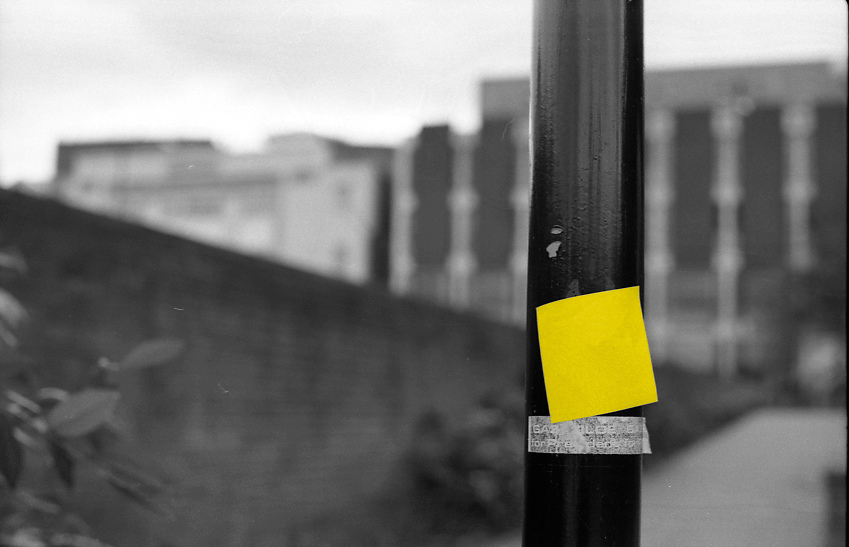The story of defending America with sticky notes, or why government needs a generation of young innovators to spread design thinking, tells the story of a small group of young govies who set out to bring innovative ideas and creative processes to the Pentagon. They failed, they learned, but now, they are succeeding as change agents.
At Tuesday’s Next Generation of Government Training Summit, Joshua Marcuse shared his story of how sticky notes helped him become a change agent in government. Marcuse is the Senior Adviser for Policy Innovation in the Office of the Under Secretary of Defense for Policy. He works on leadership development and learning, organizational change, and policy innovation.
At his keynote session, Marcuse described a typical meeting in any government office- the leader is at the head of the table telling everyone what he thinks. People have prepared dates and project updates for the meeting. Several meetings were conducted before this meeting. You tune out because the subject of the meeting has already been discussed before, and you’re clearly not given permission to talk.
Marcuse says this is not the future of government. Instead, the future is the sticky note. The virtues of the sticky note can help innovate and address status quo and inefficient processes in any government workplace. The sticky note took 12 years to develop and is now one of the most profitable products. In comparison to email, this little piece of paper is extremely powerful.
“You can only fit about 10 words on it, so you have to be succinct,” Marcuse said. “Unlike PowerPoint, they’re meant to be moved around. If I want to reorganize my ideas, I can put them on the board in different ways.”
Marcuse emphasized the flexibility of the sticky notes in enabling the user to combine ideas in nonlinear ways. Sticky notes also have a democratizing effect since they can be written anonymously. “It’s the ideas that matter, not who wrote them,” he said. “Ideas need to compete with other ideas based on merit. These ideas lead to better diversity and better decisions.”
Marcuse described the five qualities of the sticky notes:
- As a tool– what’s valuable is the ability to use the notes in infinite combinations for design and innovation. All of these methods facilitate innovation. They unlock potential by allowing people to share ideas, regardless of status as leader or intern.
- As an insult– Marcuse said people have a way of looking down on “the sticky note people.” “The sticky note has been used as a way to demean and denigrate our alternative paths to solving problems,” he said. The sticky note haters tend to put those who are innovative in a corner, as if they are children playing with toys. The innovative ideas of the sticky note are seen as naïve and reserved for employees with special interests in design.
- As a secret– “Like all people who’ve been insulted, we’ve appropriated the terms of our denigration,” Marcuse said. For him and his fellow sticky note people, it’s now a symbol of pride. Parts of government still think the only way to communicate is through thick bound policy books or PDFs. Marcuse said the sticky note is now the marker for others who are “part of the tribe.” “You may insult us and say what we do is arts and crafts,” he said. “But so much research shows these ideas are better. I won’t say I told you so when you invite me back to do workshops with you.” Using sticky notes means getting something done in the meeting, going to the whiteboard, and actually talking to some stakeholders and citizens. It also means changing sticky note ideas into powerful programs that change the lives of Americans. Marcuse said, “We understand the other meaning of the sticky note.”
- As a flag– “One day, it won’t be an underground network of innovators,” Marcuse said. “One day, we will rise up and bear it like a badge.” Sticky note people are the future of government. The flag of the sticky note represents fighting the good fight in changing government status quo. Being a sticky note person, or simply an innovator, can be tough and depressing sometimes, because others are threatened by your creativity. Marcuse concluded by saying, “My greatest fear is that all of you decide there’s a place other than government where you feel you would be more valued and you won’t come back. It’s an emotionally draining journey, but it’s absolutely worth it. You owe it to yourself and to the American people.”
From July 20th – 21st we’ll be blogging from GovLoop and YGL’s Next Generation of Government Training Summit. Follow along @NextGenGov and read more blog posts here.
Photo Credit: Flickr/Sarah Joy





Sticky notes…..the greatest tool for continuous improvement and managing multiple priorities!!
Stop the age discrimination with phrases like “why government needs a generation of young innovators”. I work in an agency that practices rampant age discrimination in IT. The assumption is anyone over 50 can’t innovate. Older employees are systematically moved from working with new technology. Many are pushed into retirement (if old enough) or quitting (in in their early 50s). Attempts the change the culture by an older employee is met with formal reprimands for “conduct not befitting” someone with say 20-30 years of experience. What the government needs is an overhaul of management thinking, more diversity, and more innovators regardless of their age.
[…] posted on GovLoop by Francesca […]